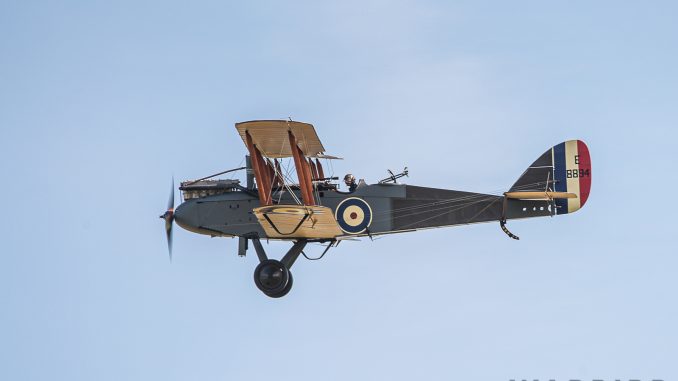
The Historic Aircraft Collection’s extraordinarily rare, WWI-era Airco DH.9 light bomber took to the skies over Duxford Aerodrome on May 13th, 2019 for its first post-restoration flight following fifteen years of dedicated conservation and restoration at Retrotec Ltd. in Westfield, East Sussex. The aircraft hadn’t flown under its own power for the best part of a century, and it is currently the only original WWI bomber flying anywhere in the world!
The DH.9, designed by the legendary Geoffrey de Havilland in 1917, was essentially a larger, modified variant of his very successful DH.4, with which it shared significant components. It was intended to fly at 15,000′ and had an internal bomb bay; a first for British designs of the day. Although it had a sound pedigree, the aircraft’s achilles heal was its powerplant, the Siddeley-Deasey Puma, which delivered at best 230 of the promised 300 HP promised. Added to this already near-fatal shortcoming, the engine was so unreliable that many DH.9s (and often their crews) were lost to engine failure. Even so, the Aircraft Manufacturing Company Ltd. (Airco – forerunner to de Havilland) built four thousand or so DH.9s, although a good number of the later variants, like the DH.9A, used the far more reliable and powerful Liberty V-12 or the Rolls-Royce Eagle Mk.VIII powerplants. Despite the type’s inauspicious beginnings, DH.9s and their variants served in more than twenty military air arms across the world, and a good number ended up with civilian operators as well. They soldiered on in every corner of the British Empire well into the 1930s, with the last flight believed to have taken place sometime in 1937.
Although Airco built several thousand DH.9s, only a handful still survive. Just three DH.9s were known to exist, none of them in the UK, before Guy Black confirmed the existence of a further three examples in India during the late 1990s. These three had been Imperial Gifts from the British in India to the maharaja Sir Ganga Singh in Bikaner, Rajasthan, although it is doubtful they ever flew with their new owner. Black found that two of the DH.9s lay dismantled in the now-disused elephant stables within the maharaja’s fortress, while a third example had been crudely put back together for display. After a lengthy period of negotiation, Guy Black was able to acquire the two stored examples, which formerly served in the Royal Air Force as D5649 and E8894. Their service histories are presently unknown, other than that both of aircraft spent time at a storage depot in Biggin Hill, near London, England during early 1918; Guy Black believes that neither of them flew in combat during WWI.
Both airframes were in understandably poor condition, and without engines, but would form the basis for one airworthy and one static example for display in England. It was clear that almost all of the wood would need to be replaced in any airworthy restoration, so in order to preserve as much original material as possible for the ground-bound example, Black chose D5649 for static restoration as its woodwork was in the best condition… albeit suffering from further indignities and damage at the hands of the team in India charged with preparing them for shipment back to England. In the years subsequent to their arrival in England, the restoration team scoured the earth looking for original parts, not to mention drawings and manufacturing details. Following a decade-long sympathetic conservation, Retrotec completed D5649 for display in 2015. This example was originally built in Hammersmith, London at Waring and Gillow, a furniture factory impressed into war work, and now she was complete again following decades of decay. She now sits proudly in the Imperial War Museum’s Airspace hangar at Duxford Aerodrome.
Due to the lack of any original drawings, and Guy Black’s determination to produce as authentic a restoration as possible, E8894 took more than fifteen years to restore. One stroke of luck came when Guy Black realized he had a complete set of DH.9 wing struts in his collection that he had acquired before starting the project. He also found a significant collection of DH.4 drawings in the Smithsonian’s archives in the USA, which provided useful data for the project since many DH.4 parts migrated to the DH.9 design. But the biggest problem was locating an appropriate, period engine to power the aircraft. Since the Siddeley-Deasy Puma was never used on any other production aircraft, for obvious reasons, it has become exceedingly rare, with just a handful or so rebuildable examples still in existence, and none available for acquisition. However, Guy Black was able to locate an even rarer Beardmore Halford Pullinger (BHP) engine within the Canada Aviation & Space Museum’s collection in Ottawa, Canada. Interestingly, the BHP was used in the early examples of the DH.9 before Siddeley-Deasy took up its production as the Puma. Rushed into production, there were many design faults, but one of them seemed so egregious as to be unbelievable. The connecting rods had their part number and inspection stamp crudely whacked into them at precisely the same spot where most of the failures seemed to occur. As a result, the restored engine incorporates newly manufactured con-rods, sans the troublesome stampings, so they should be more reliable than the originals. Retrotec conducted the first engine runs with the BHP powerplant mounted in E8894 during October, 2018. There is a wonderful video available below which should give our readers a good idea of what this ancient engine sounds like…
The first flight took place at Duxford on May 13th, and our very own George Land was on hand to record the details. George reports the details as follows…
“After many years of painstaking labor, the dream became reality when in October of 2018 E8894’s first engine runs occurred, followed by ground testing and taxi runs that November.
Finally on May 13th, 2019, we where lucky to witness the first flight of an authentic DH.9 in many long years when test pilot Dodge Bailey, who is one of the most experienced vintage biplane pilots in the UK, finally felt that everything was in order for a test flight. He took E8894 into the air using an into-the-wind, cross-field take-off on the grass from the west end of RAF Duxford for the first time.
After numerous circuits of the airfield at differing heights, Dodge Bailey took the DH.9 on a run down the field in front of the tower before bringing the historic WWI bomber around for a safe cross-field landing and a successful conclusion to her first flight following restoration.
Since then, a number of flights have taken place and it is hoped that the first public display might take place during the Flying Legends air show at Duxford on July 13th.”
Obviously, given the nature of its engine, the DH.9 will only fly occasionally, but it is marvelous to see it flying again; a tangible link to our collective past that is all down to the perspicacity of Guy Black and the ingenuity and hard work of all those at Retrotec Ltd. and HAC. As some will know, the Historic Aircraft Collection, and their restoration arm, Retrotec, have a prodigious reputation for unusual and complex restorations. These include a unique survivor of the Hawker Fury interwar biplane fighter, perhaps the most beautiful biplane ever built… at least to your editor’s eyes… and a Hawker Nimrod Mk.II (a navalized Fury) to name a few. Currently, they are working on the resurrection of de Havilland Mosquito NF.36 RL249 for another client.
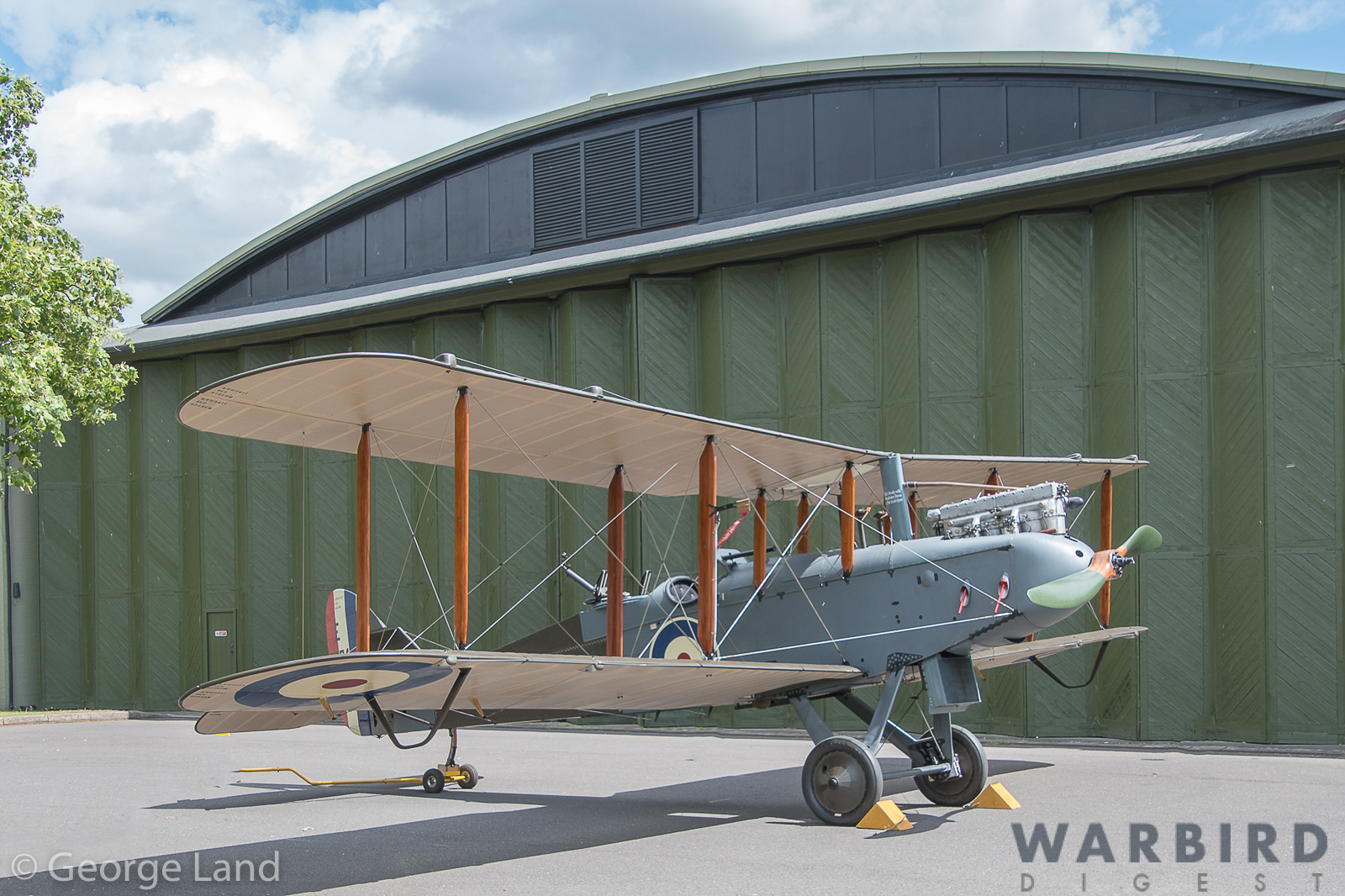
Richard Mallory Allnutt's aviation passion ignited at the 1974 Farnborough Airshow. Raised in 1970s Britain, he was immersed in WWII aviation lore. Moving to Washington DC, he frequented the Smithsonian’s National Air & Space Museum, meeting aviation legends.
After grad school, Richard worked for Lockheed-Martin but stayed devoted to aviation, volunteering at museums and honing his photography skills. In 2013, he became the founding editor of Warbirds News, now Vintage Aviation News. With around 800 articles written, he focuses on supporting grassroots aviation groups.
Richard values the connections made in the aviation community and is proud to help grow Vintage Aviation News.


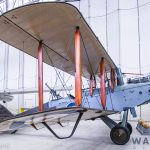
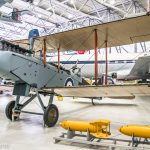
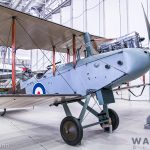
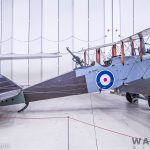
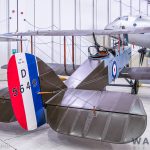
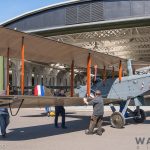
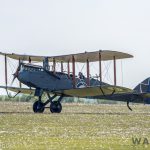
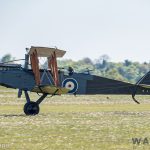
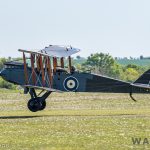
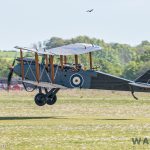
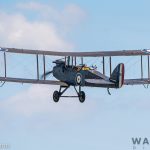
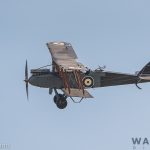
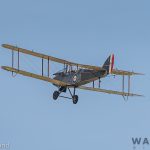
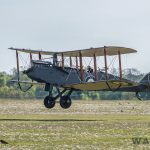
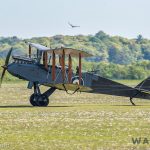
Be the first to comment
Graphic Design, Branding and Aviation Art